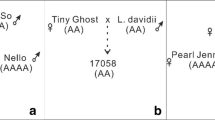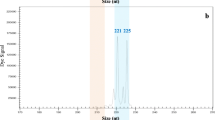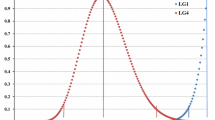Abstract
Meiotic polyploidisation via crossing with 2n gamete producing genotypes and interploidy crosses are two of the main methods currently used to obtain polyploid tulips. In our study diploid 2n gamete producing F1 hybrids of Darwin hybrids (Tulipa gesneriana × Tulipa fosteriana) and triploid hybrid resulting from ‘Rhodos’ × ‘Princeps’ cross were used as pollen donor and crossed with cultivars of T. gesneriana in the following combination: 2x × 2x, 3x × 2x, 2x × 3x, and 3x × 3x. The progenies resulting from crosses at diploid level were mostly diploid, whereas a few seedlings were triploid. In 3x × 2x crosses aneuploids with chromosome constitution in between triploid and tetraploid (43–45 chromosomes) were predominant, but also one tetraploid (2n = 4x = 48) and four pentaploids (2n = 5x = 60) were obtained. In 2x × 3x crosses most progenies were triploid with the exception of a few aneuploids (3x + 1 and 3x − 1), whereas in 3x × 3x cross diploid and aneuploid genotypes were recorded with chromosome number varied from 27 to 34. These results indicate that triploid parents produced aneuploid as well as euploid (x, 2x, 3x) gametes and that success in ploidy manipulation in tulip depends to a large degree on the ploidy level of the parental genotypes used for hybridization. Genome constitution of selected population of F1 and BC1 hybrids was analyzed through genomic in situ hybridization (GISH). GISH analysis of the BC1 showed a considerable amount of intergenomic recombination which is desirable for introgression breeding.



Similar content being viewed by others
References
Bamford R, Reynard GB, Bellows JM Jr (1939) Chromosome number in some tulip hybrids. Bot Gaz 101:482–490
Barba-Gonzalez R, Lokker AC, Lim KB, Ramanna MS, Van Tuyl JM (2004) Use of 2n gametes for the production of sexual polyploids from sterile Oriental × Asiatic hybrids of lilies (Lilium). Theor Appl Genet 109:1125–1132
Barba-Gonzalez R, Lim KB, Ramanna MS, Visser RGF, Van Tuyl JM (2005) Occurrence of 2n gametes in the F1 hybrids of Oriental × Asiatic lilies (Lilium): relevance to intergenomic recombination and backcrossing. Euphytica 143:67–73
Barba-Gonzalez R, Miller CT, Ramanna MS, Van Tuyl JM (2006a) Induction of 2n gametes for overcoming F1-sterility in lily and tulip. Acta Hort 714:99–106
Barba-Gonzalez R, Van Silfhout A, Visser RGF, Ramanna MR, Van Tuyl JM (2006b) Progenies of allotetraploids of Oriental × Asiatic lilies (Lilium) examined by GISH analysis. Euphytica 151:243–250
Barba-Gonzalez R, Lim KB, Zhou S, Ramanna MS, Van Tuyl JM (2008) Interspecific hybridization in Lily: the use of 2n gametes in interspecific lily hybrids. In: Allen L (ed) Floriculture, ornamental plant breeding, 5th edn. Global Science Books, London
Brandham PE (1982) Inter-embryo competition in the progeny of autotriploid Aloineae (Liliaceae). Genetica 59:29–42
Chauvin JE, Label A, Kermarrec MP (2006) In vitro chromosome-doubling in tulip (Tulipa gesneriana L.). J Hortic Sci Biotechnol 80:693–698
Chen C, Lyon MT, O’Malley D, Federici CT, Gmitter J, Grosser JW, Chaparro JX, Roose ML, Gmitter FG Jr (2008) Origin and frequency of 2n gametes in Citrus sinensis × Poncirus trifoliate and their reciprocal crosses. Plant Sci 174:1–8
Eikelboom W, Straathof ThP, Van Tuyl JM (2001) Tetraploide “Christmas Marvel” methoden om tetrapoide tulpen te verkrijgen. Bloembollencultuur 112:22–23
Fulton ThM, Chunzoongse J, Tanksley SD (1995) Micropreparation protocol for extraction of DNA from tomato and other Herbaceous plants. Plant Mol Biol Rep 13:207–209
Holitscher O (1968) Pruhonicky sortiment tulipanu. Acta Pruh 18:1–215
Johnston SA, Den Nijs TMP, Peloquin SJ, Hanneman RE Jr (1980) The significance of genic balance to endosperm development in intraspecific crosses. Theor Appl Genet 57:5–9
Khan N, Barba-Gonzalez R, Ramanna MS, Visser RGF, Van Tuyl JM (2009) Construction of chromosomal recombination maps of three genomes of lilies (Lilium) based on GISH analysis. Genome 52:238–251
Khan N, Barba-Gonzalez R, Ramanna MS, Arens P, Visser RGF, Van Tuyl JM (2010) Relevance of unilateral and bilateral sexual polyploidisation in relation to intergenomic recombination and introgression in Lilium species hybrids. Euphytica 171:157–173
Kroon GH (1975) Chromosome numbers of garden tulips. Acta Bot Neerl 24:489–490
Kroon GH, Jongerius MC (1986) Chromosome numbers of Tulipa species and the occurrence of hexaploidy. Euphytica 35:73–76
Kroon GH, Van Eijk JP (1977) Polyploidy in tulips (Tulipa L.). The occurrence of diploid gametes. Euphytica 26:63–66
Lim KB, Ramanna MS, De Jong JH, Jacobsen E, Van Tuyl JM (2001) Indeterminate meiotic restitution (IMR): a novel type of meiotic nuclear restitution mechanism detected in interspecific lily hybrids by GISH. Theor Appl Genet 103:219–230
Lim KB, Ramanna MS, Jacobsen E, Van Tuyl JM (2003) Evaluation of BC2 progenies derived from 3x − 2x and 3x − 4x crosses of Lilium hybrids: a GISH analysis. Theor Appl Genet 106:568–574
Lim KB, Shen TM, Barba-Gonzalez R, Ramanna MS, Van Tuyl JM (2004) Occurrence of SDR 2n-gametes in Lilium hybrids. Breed Sci 54:13–18
Marasek A, Okazaki K (2007) GISH analysis of hybrids produced by interspecific hybridization between T. gesneriana and T. fosteriana. Acta Hort 743:133–137
Marasek A, Okazaki K (2008) Analysis of introgression of the Tulipa fosteriana genome into Tulipa gesneriana using GISH and FISH. Euphytica 160:217–230
Marasek A, Mizuochi H, Okazaki K (2006) The origin of Darwin hybrid tulips analyzed by flow cytometry. Karyotype analyses and genomic in situ hybridization. Euphytica 151:279–290
Marasek-Ciolakowska A, Ramanna MS, Van Tuyl JM (2009) Introgression breeding in genus Tulipa analysed by GISH. Acta Hort 836:105–110
Marasek-Ciolakowska A, Ramanna MS, Van Tuyl JM (2011) Introgression of chromosome segments of T. fosteriana into T. gesneriana detected through GISH and its implications for breeding virus resistance tulips. Acta Hort 885:175–182
Marasek-Ciolakowska A, He H, Bijman P, Ramanna MS, Arens P, Van Tuyl JM (2012a) Assessment of intergenomic recombination through GISH analysis of F1, BC1 and BC2 progenies of Tulipa gesneriana and Tulipa fosteriana. Plant Syst Evol 298:887–899
Marasek-Ciolakowska A, **e S, Ramanna MS, Arens P, Van Tuyl JM (2012b) Meiotic polyploidisation in Darwin hybrid tulips. Acta Hort 953:187–192
Mizuochi H, Matsuzaki H, Moue T, Okazaki K (2009) Diploid endosperm formation in Tulipa spp. And identification of a 1:1 maternal to paternal genome ratio in endosperm of Tulipa gesneriana L. Sex Plant Rep 1:27–36. doi:10.1007/s00497-008-0088-6
Okazaki K (2005) New aspects of tulip breeding: embryo culture and polyploidy. Acta Hort 673:127–140
Okazaki K, Nishimura M (2000) Ploidy of progenies crossed between diploids, triploids and tetraploids in tulip. Acta Hort 522:127–134
Okazaki K, Kurimoto K, Miyajima I, Enami A, Mizuochi H, Matsumoto Y, Ohya H (2005) Induction of 2n pollen in tulips by arresting the meiotic process with nitrous oxide gas. Euphytica 143:101–114
Plavcová O, Holitscher D, Petrova E (1976) Dinitrogen-oxide induction of polyploidy in Tulip. Sbornik Uvtiz-Zahradni Ctvi 3:207–216
Ramanna MS, Jacobsen E (2003) Relevance of sexual polyploidisation for crop improvement—a review. Euphytica 133:3–18
Ramanna MS, Kuipers AGJ, Jacobsen E (2003) Occurrence of numerically unreduced (2n) gametes in Alstroemeria interspecific hybrids and their significance for sexual polyploidisation. Euphytica 133:95–106
Ramanna MS, Marasek-Ciolakowska A, **e S, Khan N, Van Tuyl JM (2012) The significance of polyploidy for Bulbous ornamentals: a molecular cytogenetic assessment. In: Van Jaap Tuyl, Paul Arens (eds) Floriculture and ornamental biotechnology, 6th edn. Global Science Books, London, pp 116–121
Stephens LC (1998) Formation of unreduced pollen by an impatiens Hawkeri × Platypetala interspecific hybrid. Hereditas 128:251–255
Straathof ThP, Eikelboom W (1997) Tulip breeding at PRI. Daffodil Tulip Yearbook 8:27–33
Upcott M, Philip J (1939) The genetic structure of Tulipa IV. Balance, selection and fertility. J Genetics 38:91–123
Van Laere K, Dewitte A, Van Huylenbroeck J, Van Bockstaele E (2009) Evidence for the occurrence of unreduced gametes in interspecific hybrids of Hibiscus. J Hort Sci Biotech 84:240–247
Van Scheepen J (1996) Classified list and international register of Tulip names. Royal General Bulbgrowers’ Association KAVB, Hillegom
Van Tuyl JM, Boon E (1997) Variation in DNA-content in the genus Lilium. Acta Hort 430:829–835
Van Tuyl JM, Van Creij MGM (2007) Tulipa gesneriana and Tulip hybrids. In: Anderson NO (ed) Flower breeding and genetics. Springer, Oklahoma, pp 623–641
Van Tuyl JM, Meijer B, Van Diën MP (1992) The use of oryzalin as an alternative for colchicine in in vitro chromosome doubling of Lilium and Nerine. Acta Hort 352:625–630
Van Tuyl JM, Lim KB, Ramanna MS (2002) Interspecific hybridization and introgression. In: Vainstein A (ed) Breeding for ornamentals: classical and molecular approaches. Kluwer Academic Publishers, Dordrecht, pp 85–103
**e S, Khan N, Ramanna MS, Niu L, Marasek-Ciolakowska A, Arens P, Van Tuyl JM (2010) An assessment of chromosomal rearrangements in neopolyploids of Lilium hybrids. Genome 53:439–446
Zeilinga AE, Schouten HP (1968a) Polyploidy in garden Tulips. I. Survey of Tulipa varieties for polyploids. Euphytica 17:252–264
Zeilinga AE, Schouten HP (1968b) Polyploidy in garden Tulips. II. The production of tetraploids. Euphytica 17:303–310
Zhong C, Zhang S-n Yu, X-h Li Y, X-l Hou, Li S-j (2010) Studies on the induction of 2n gametes in Chinese cabbage and the production of tetraploid by sexual polyploidisation. Acta Hort Sinica 37:1789–1795
Zhou S, Ramanna MS, Visser RGF, Van Tuyl JM (2008) Genome composition of triploid lily cultivars derived from sexual polyploidization of Longiflourm × Asiatic hybrids (Lilium). Euphytica 160:207–215
Zwierzykowski Z, Tayyar R, Brunell M, Lukaszewski AJ (1998) Genome recombination in intergeneric hybrids between tetraploid Festuca pratensis and Lolium multiflorum. J Heredity 89:324–328
Acknowledgments
The authors wish to thank Prof. Keiichi Okazaki (Niigata University, Faculty of Agriculture, Niigata, Japan) for his valuable comments on the manuscript.
Author information
Authors and Affiliations
Corresponding author
Rights and permissions
About this article
Cite this article
Marasek-Ciolakowska, A., **e, S., Arens, P. et al. Ploidy manipulation and introgression breeding in Darwin hybrid tulips. Euphytica 198, 389–400 (2014). https://doi.org/10.1007/s10681-014-1115-3
Received:
Accepted:
Published:
Issue Date:
DOI: https://doi.org/10.1007/s10681-014-1115-3




